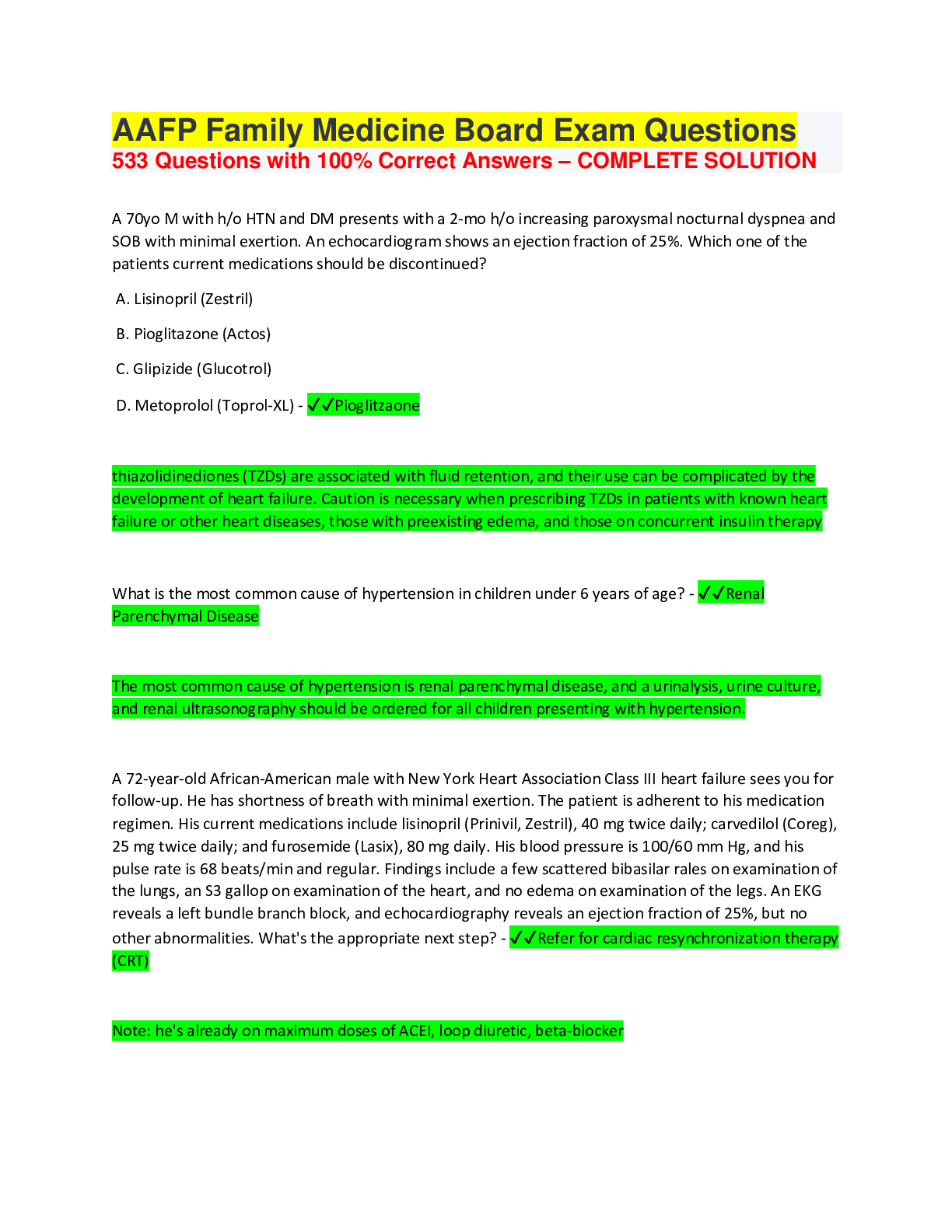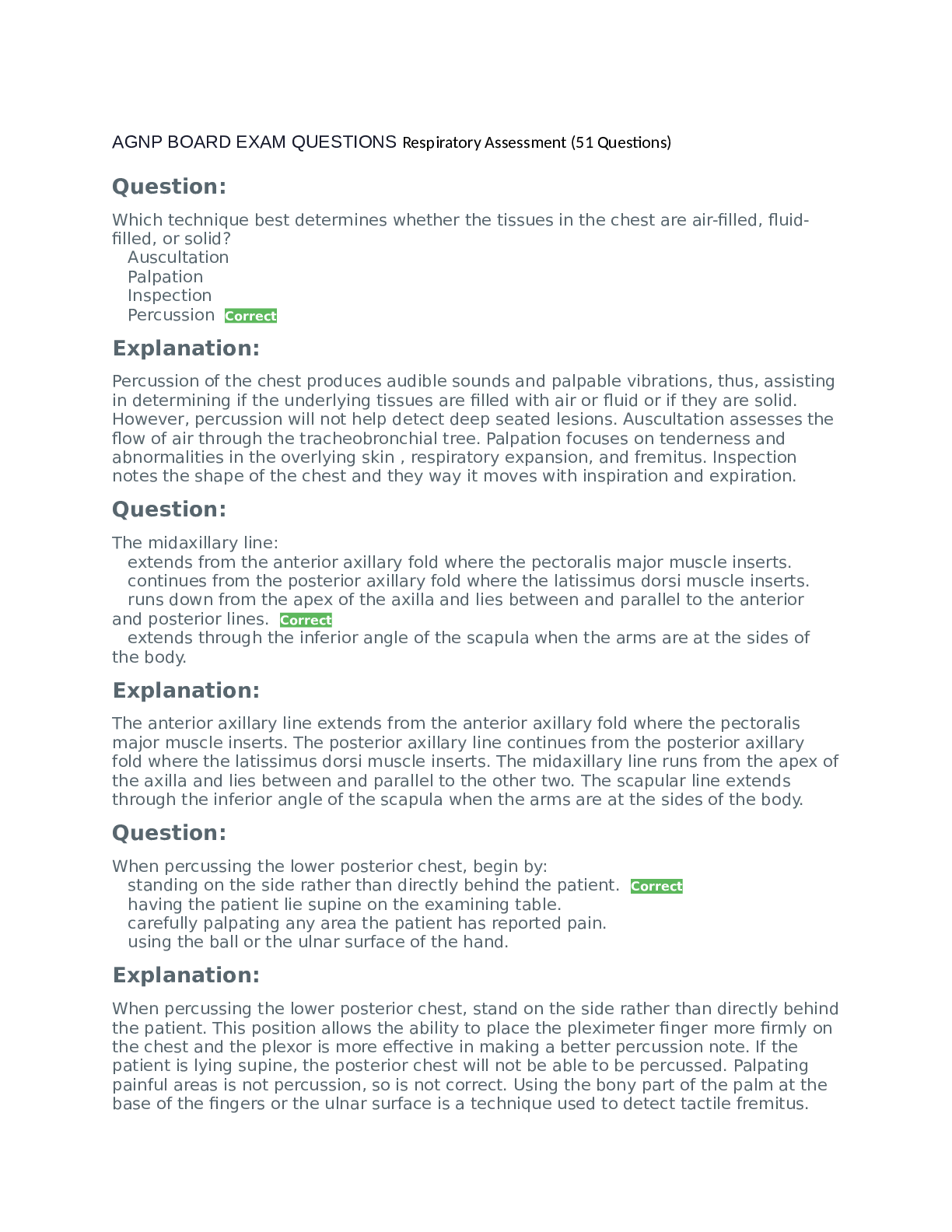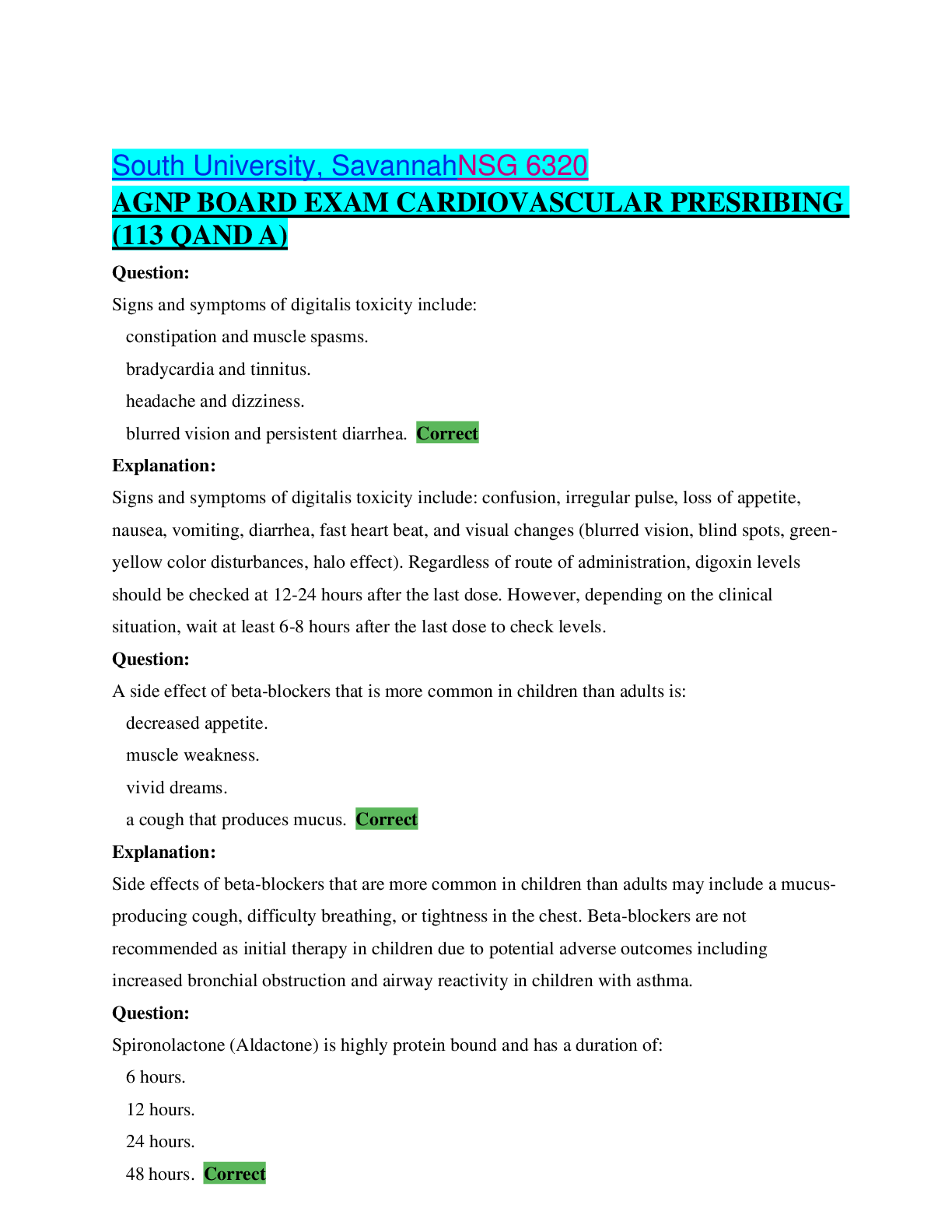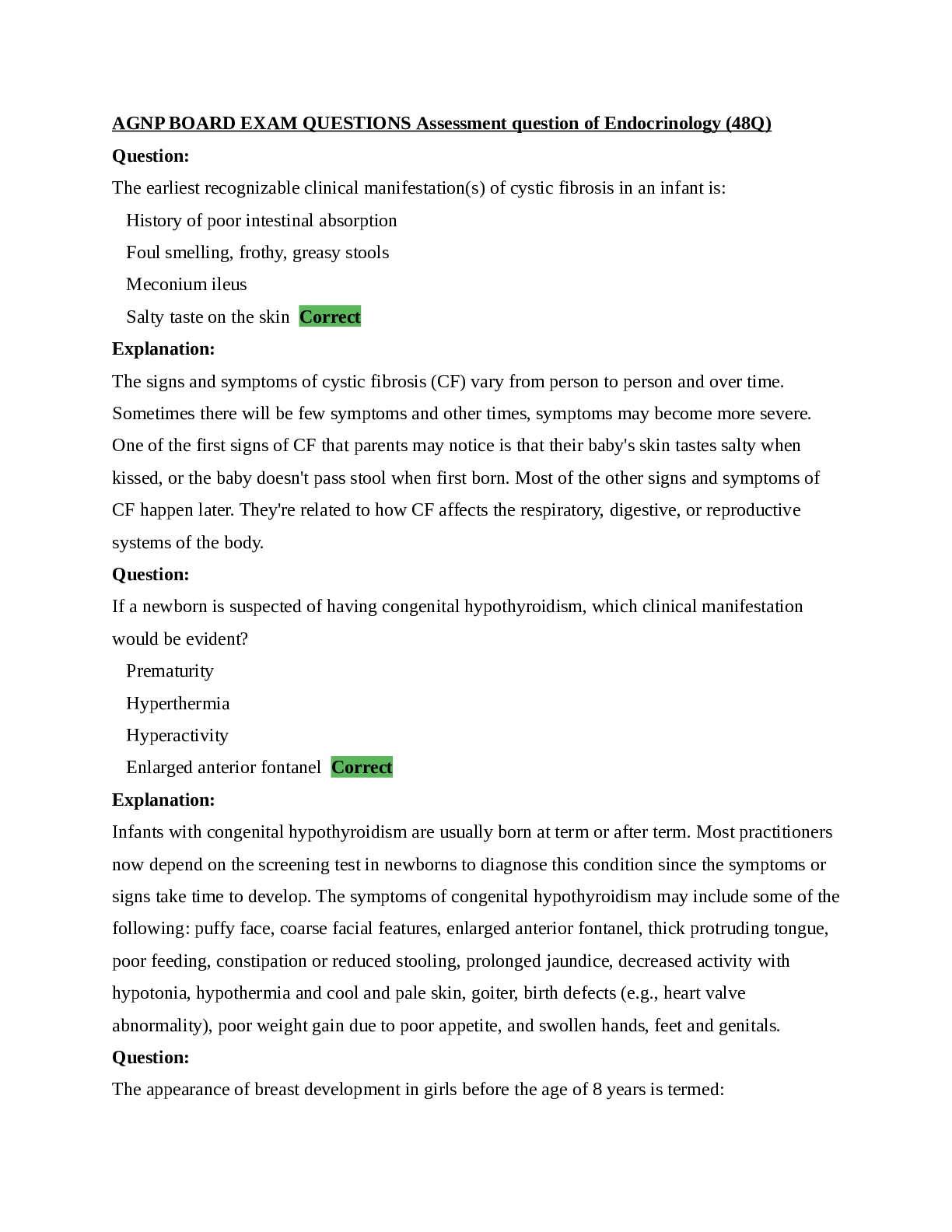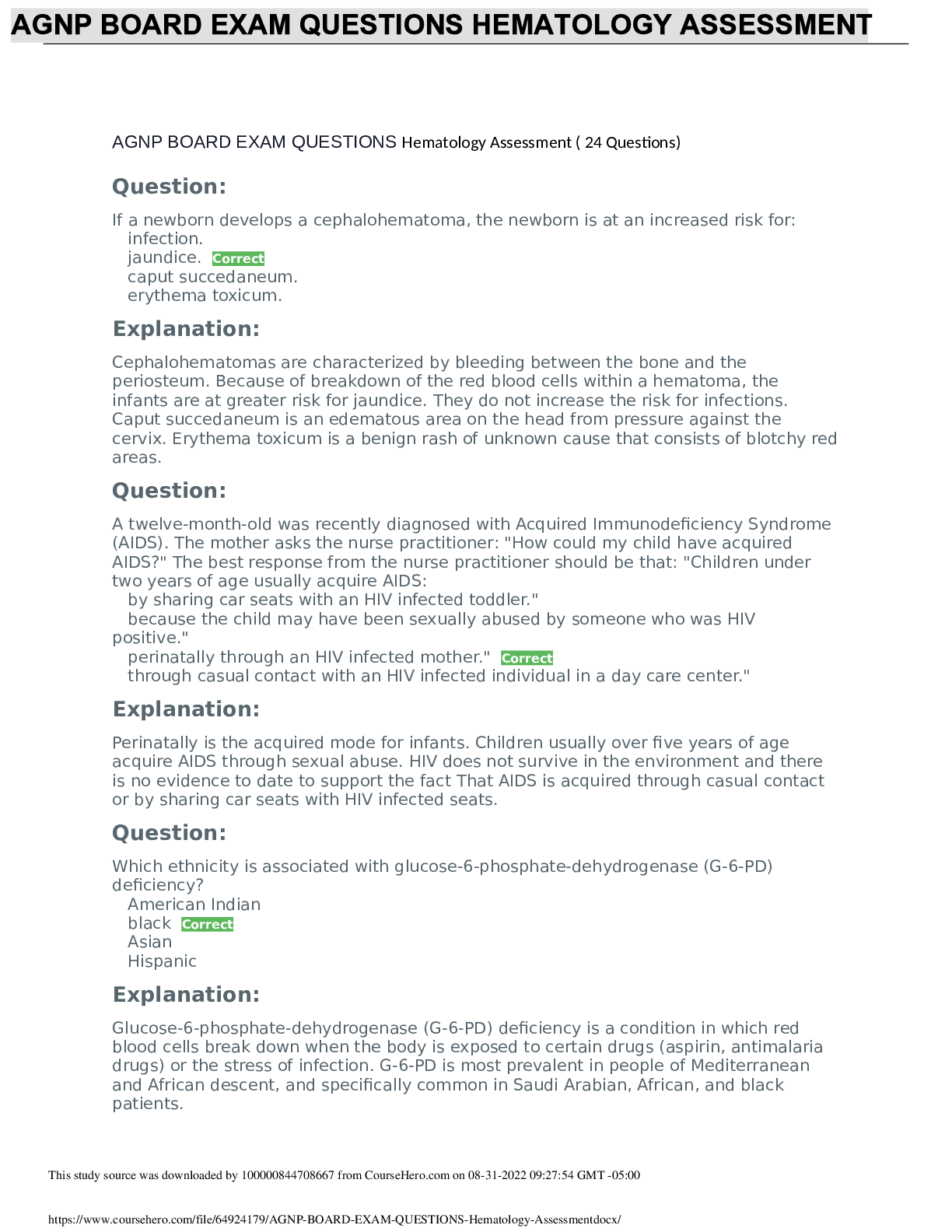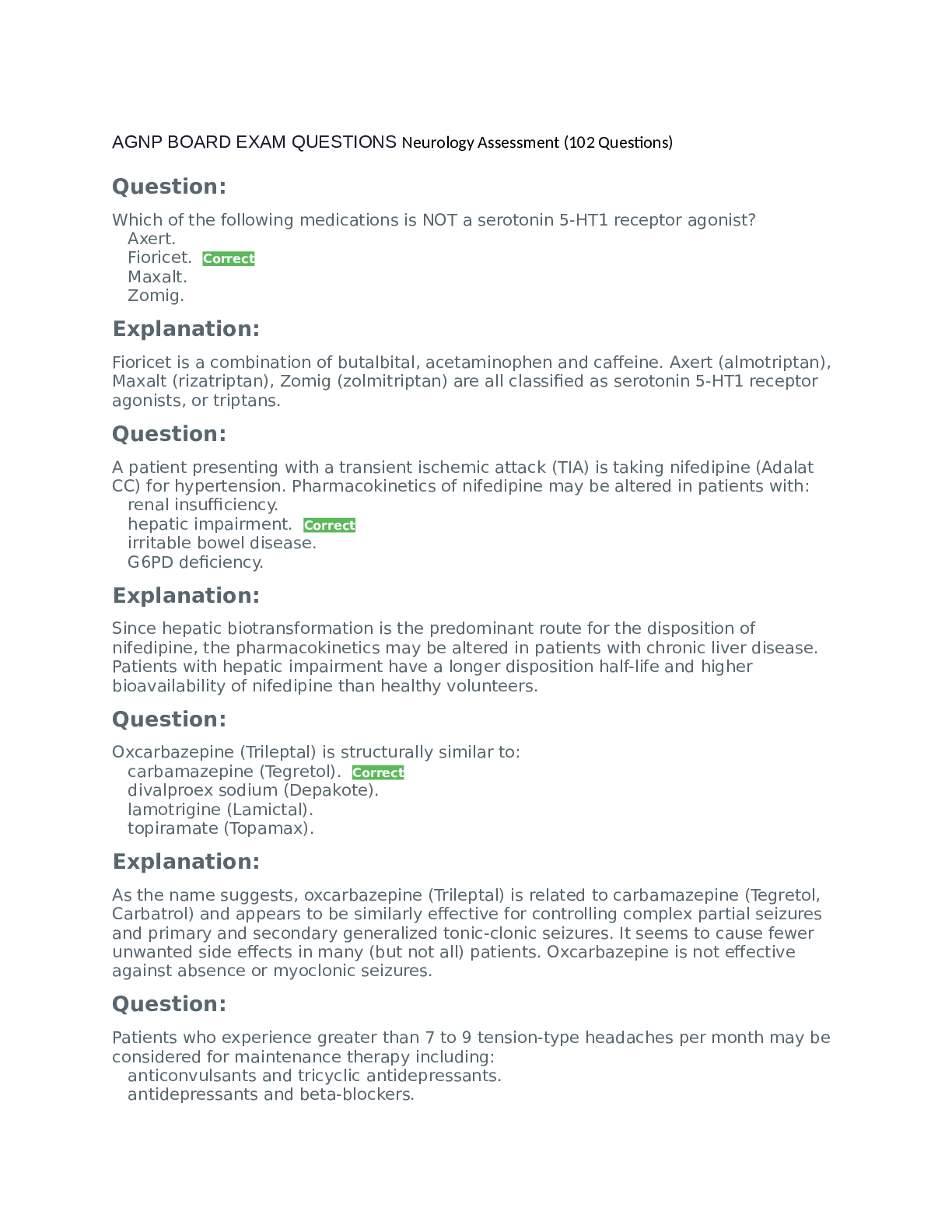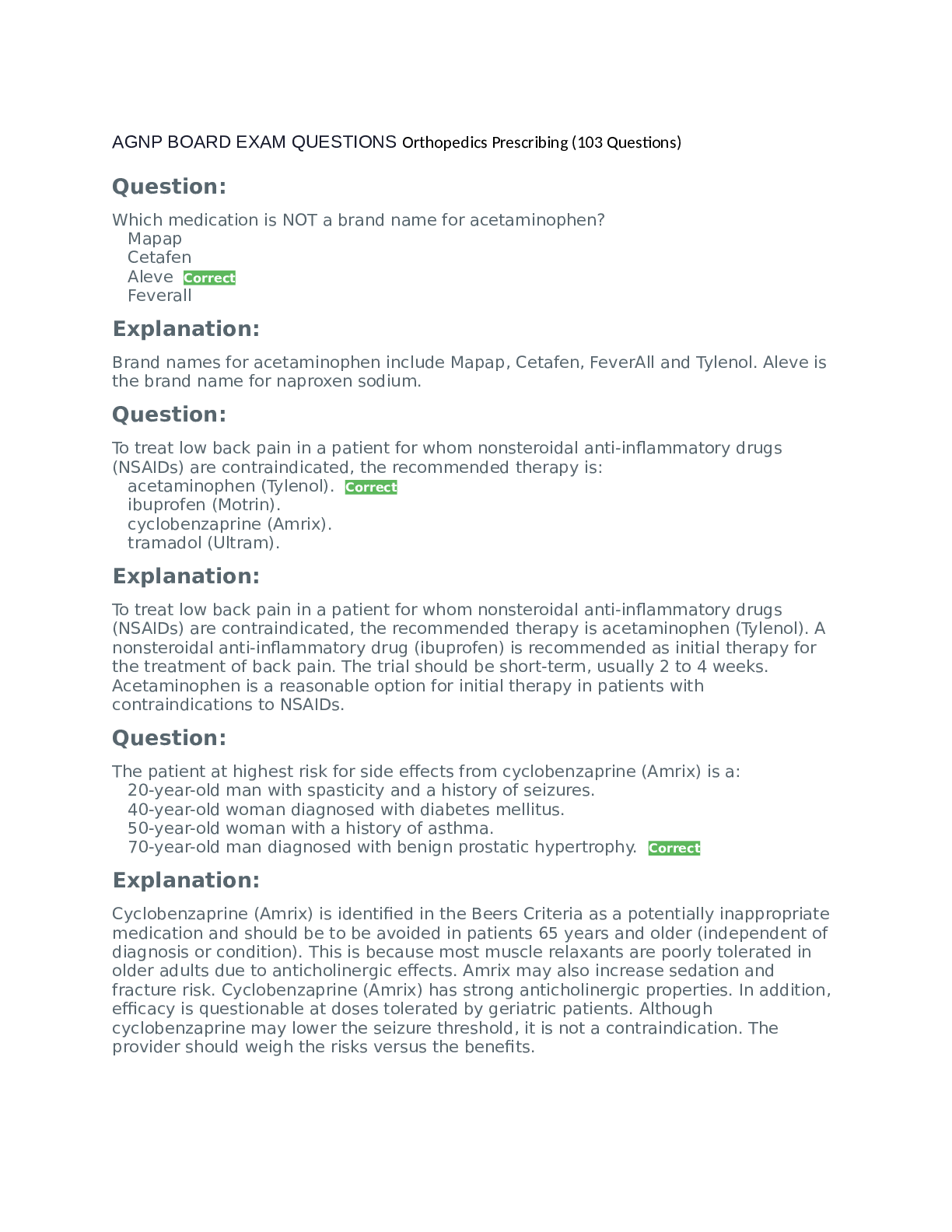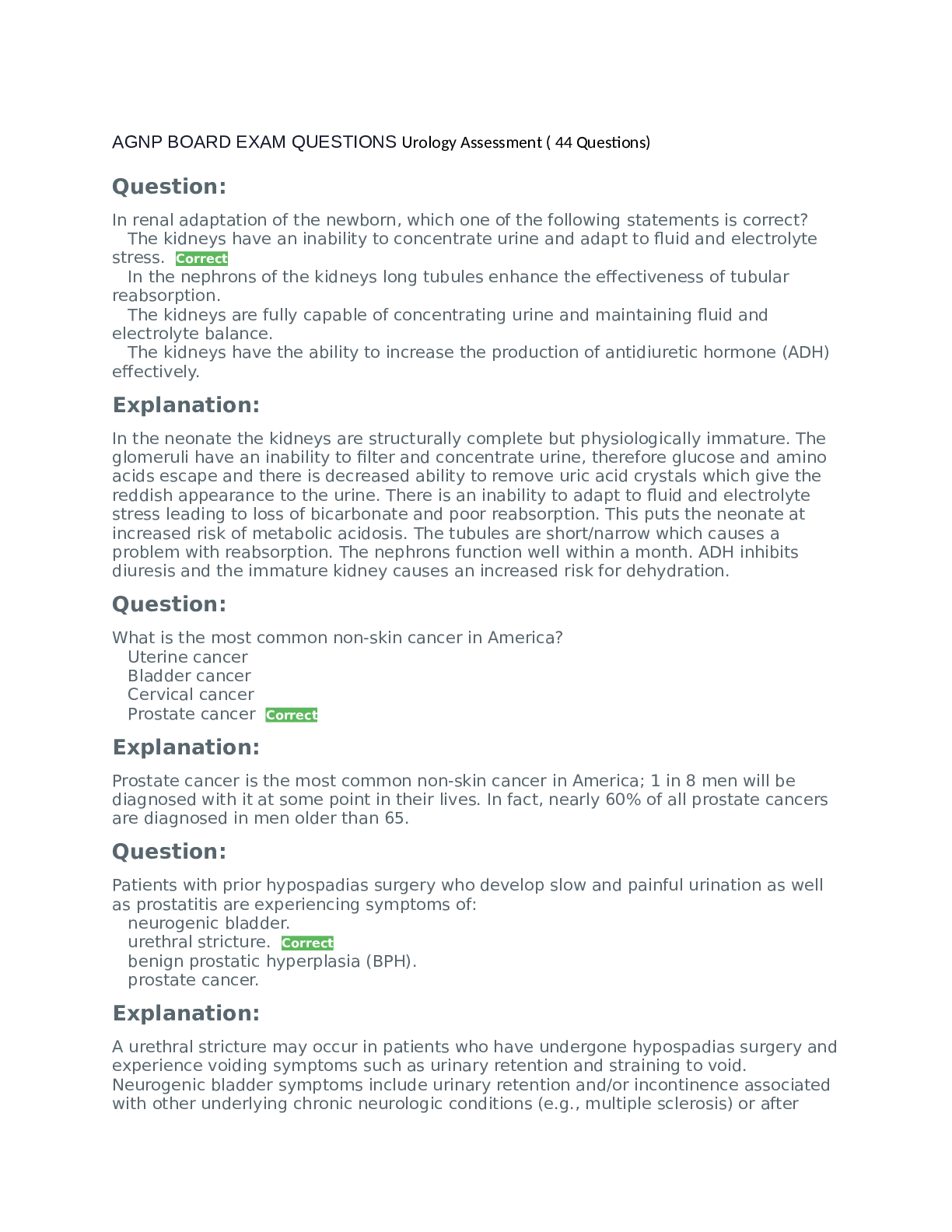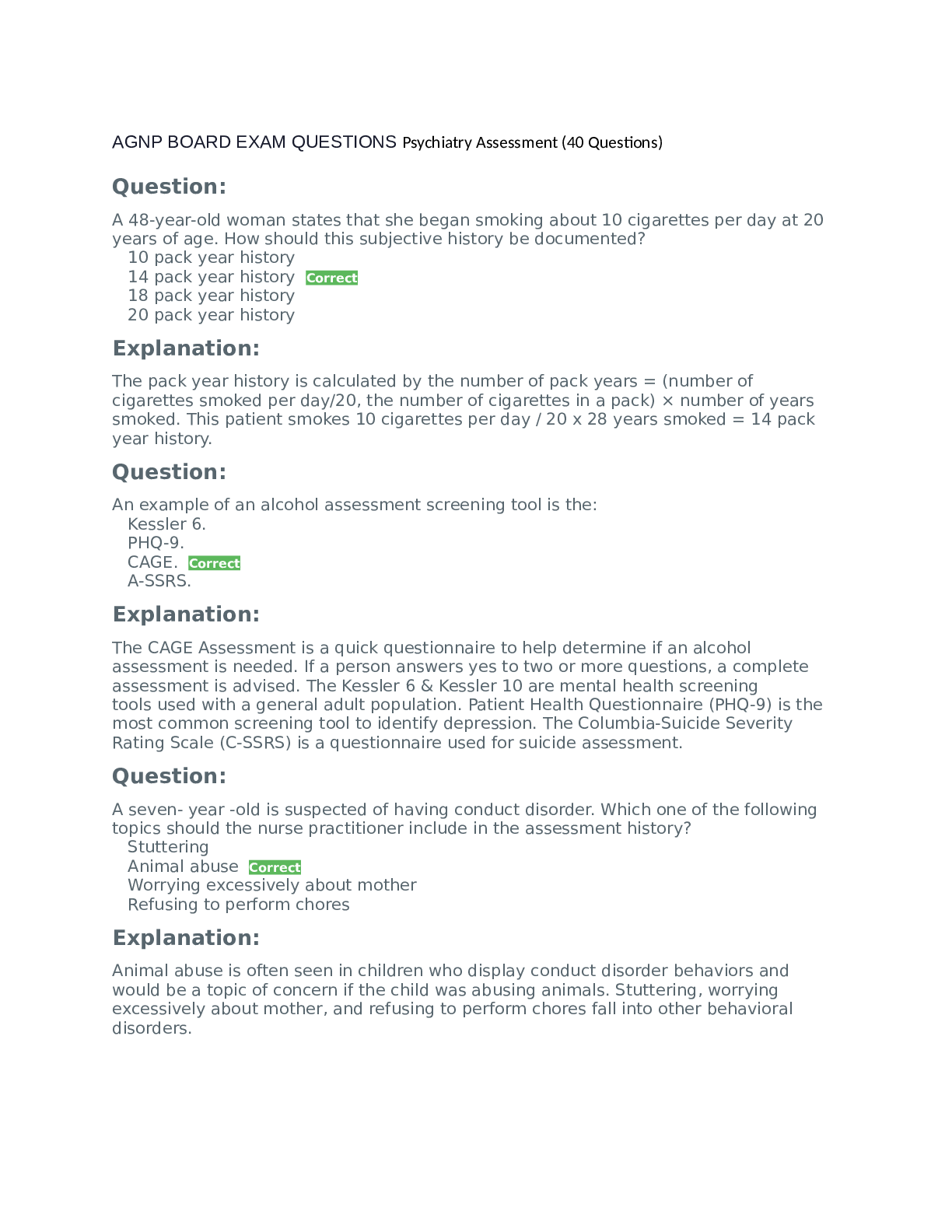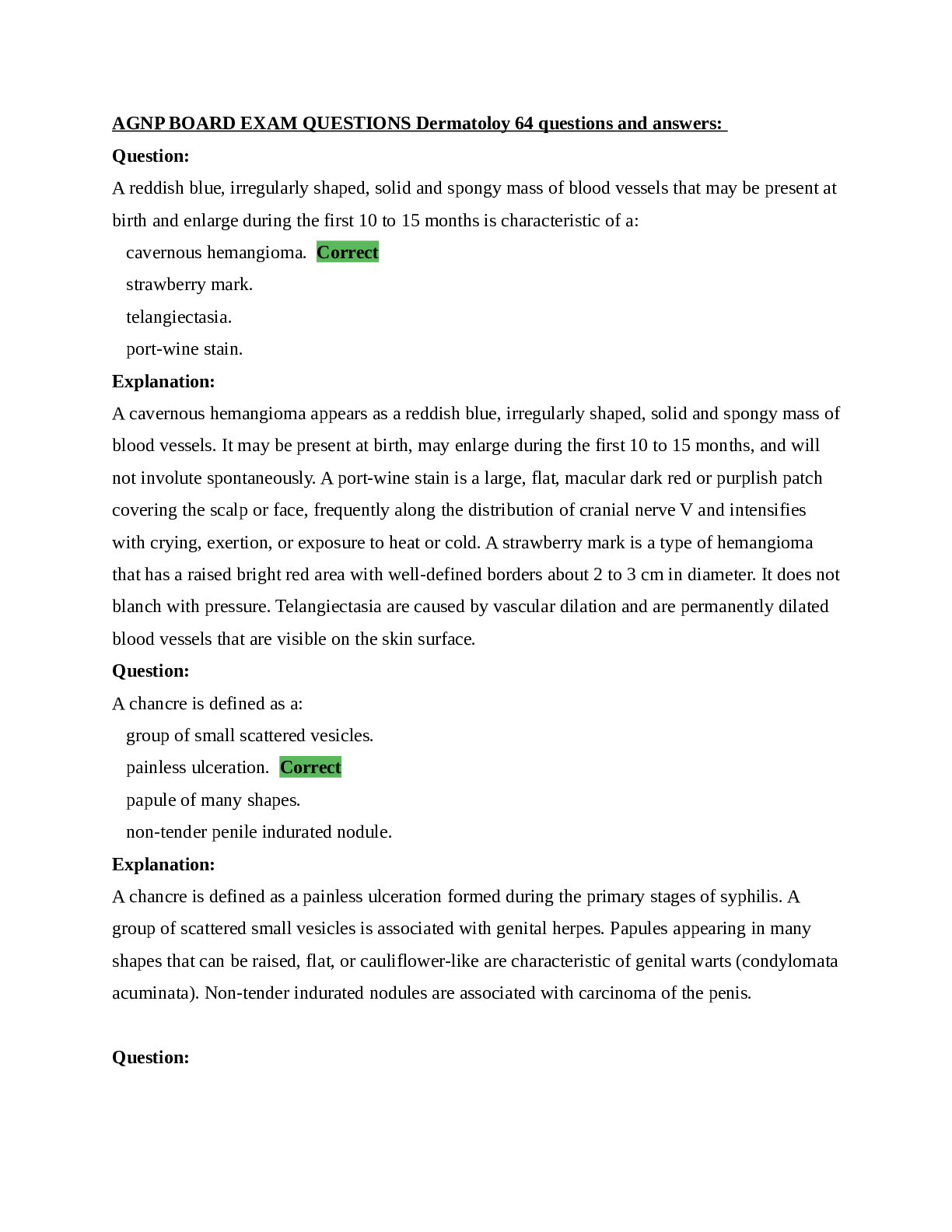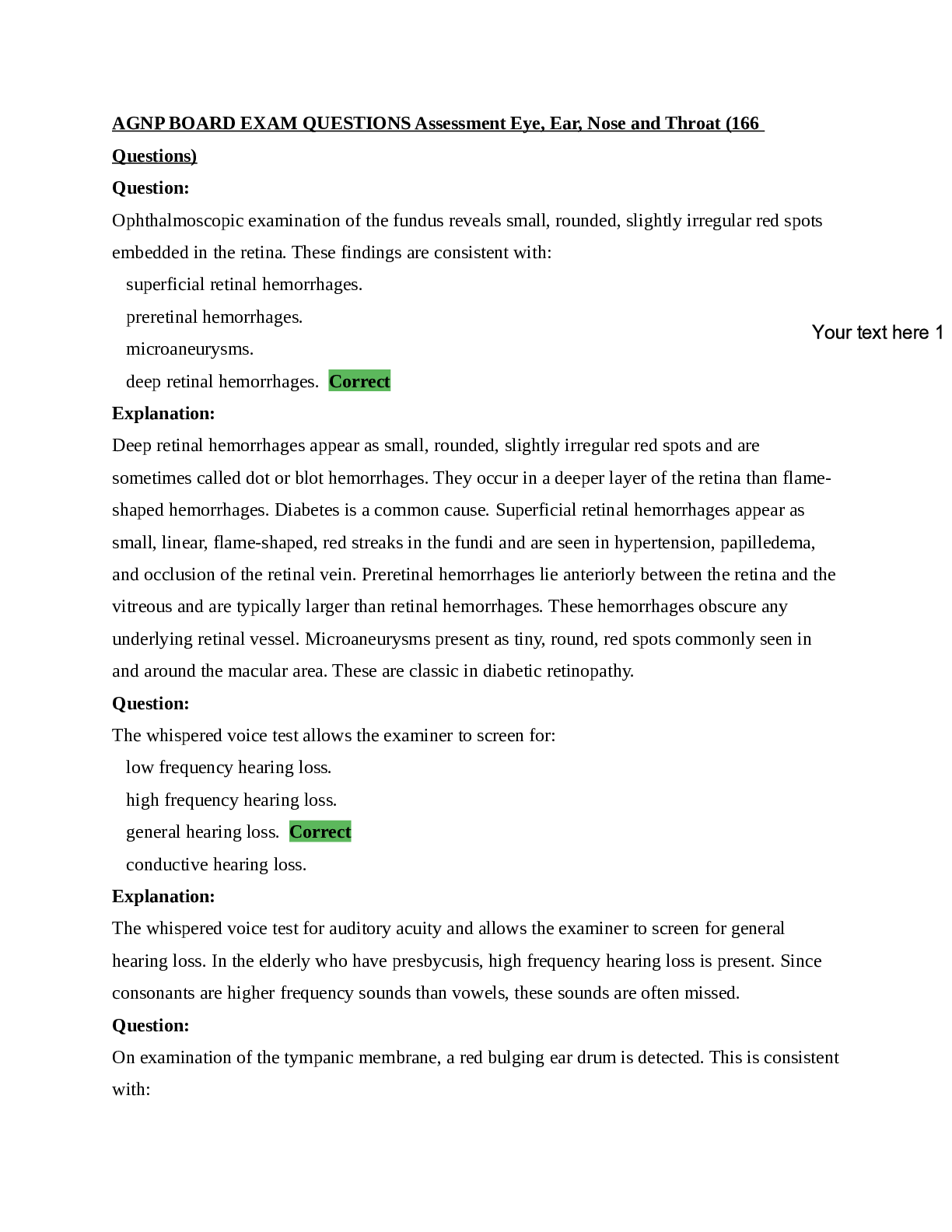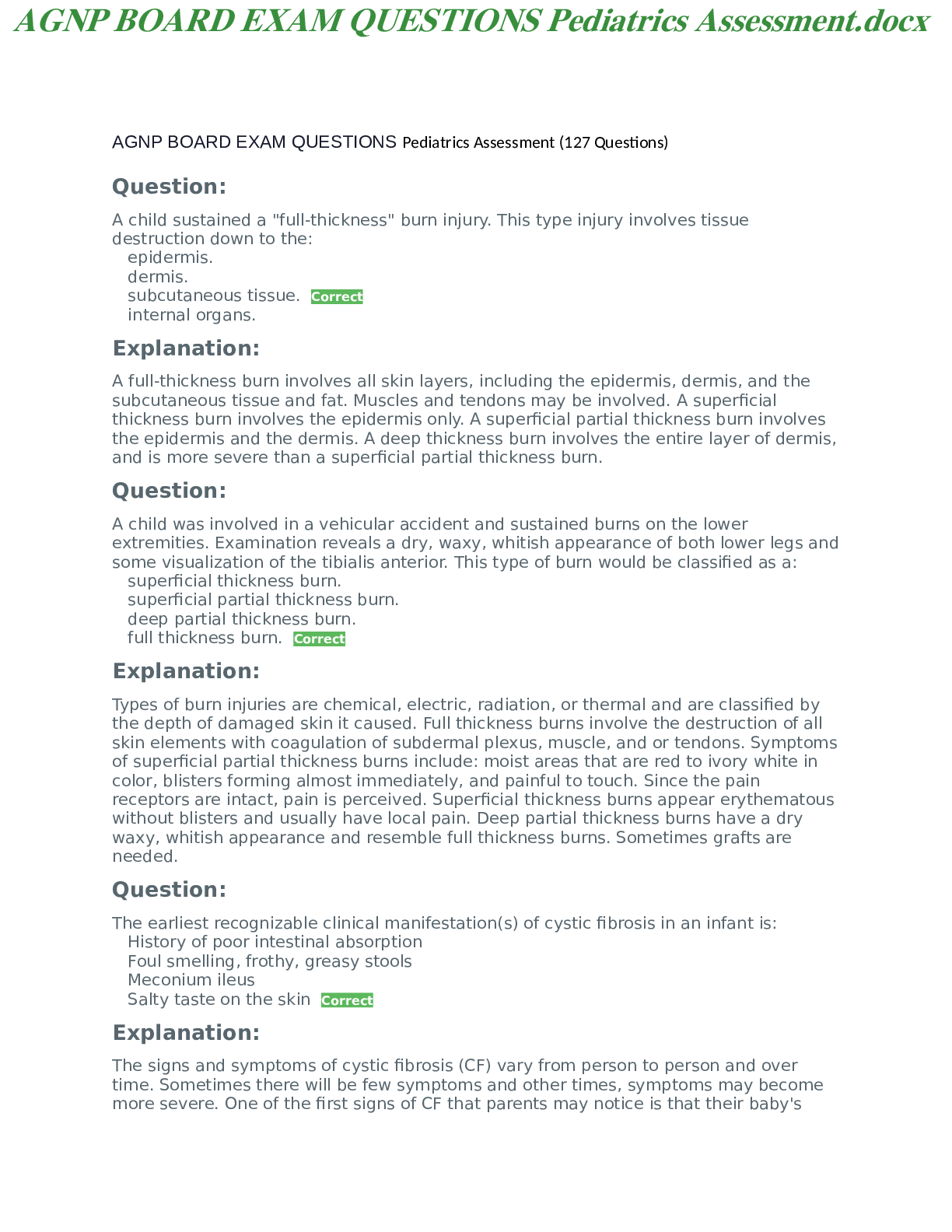*NURSING > QUESTIONS & ANSWERS > South University, Savannah NSG 6320AGNP BOARD EXAM QUESTIONS Pregnancy Assessment Already Passed (All)
South University, Savannah NSG 6320AGNP BOARD EXAM QUESTIONS Pregnancy Assessment Already Passed
Document Content and Description Below
AGNP BOARD EXAM QUESTIONS Pregnancy Assessment (67 Questions) Question: Weight gain should be monitored during pregnancy. For a pregnant woman whose BMI is < 18.5, the total weight gain should be: ... 11-20 pounds. 15-25 pounds. 25-35 pounds 28-40 pounds. Correct Explanation: Weight gain should be closely monitored during pregnancy, as both excessive and inadequate weight gain are associated with poor birth outcomes. The pregnant woman who has a BMI of <18.5, should gain 28 - 40 pounds; BMI 18.5-24.9 should gain 25 - 35 pounds; BMI 25-29.9 should gain 15 - 25 pounds; and the obese pregnant woman should gain 11 - 20 pounds. Question: During pregnancy, which hormone is produced by the placenta and supports progesterone synthesis in the corpus luteum? Progesterone Human chorionic gonadotropin (HCG) Correct Estrogen Human placental lactogen Explanation: Human chorionic gonadotropin (HCG) is produced by the placenta and supports progesterone synthesis in the corpus luteum, effectively preventing the early embryo from being lost to menstruation. Question: During pregnancy, as the skin over the abdomen stretches to accommodate the fetus, this purplish mark may appear. This finding is: Hegar's sign. Chadwick's sign. striae gravidarum. Correct linea nigra. Explanation: As the skin over the abdomen stretches to accommodate the fetus, purplish striae gravidarum (“stretch marks”) may appear. Linea nigra is a brownish black pigmented vertical stripe along the midline skin. Hegar’s sign is the palpable softening of the cervical isthmus, the portion of the uterus that narrows into the cervix. Increased vascularity throughout the pelvis during pregnancy gives the vagina a bluish color, known as Chadwick’s sign. Question: When should all pregnant woman be screened for human immunodeficiency virus (HIV)? Routine screening is not recommended At the first prenatal visit Correct During the second trimester During the third trimester Explanation: The Centers for Disease Control and Prevention (CDC) recommends screening of all pregnant women for human immunodeficiency virus (HIV) at the first prenatal visit. During the third trimester, women at high risk for acquiring HIV infection should be rescreened. Question: Irregular brownish patches around the forehead, cheeks, nose, and jaw noted during pregnancy are: pallor. nevi. chloasma. Correct hirsutism. Explanation: Irregular brownish patches around the forehead, cheeks, nose, and jaw noted during pregnancy are known as chloasma (or melasma) or the "mask of pregnancy". This is considered a normal finding. Question: After 24 weeks gestation, auscultation of more than one fetal heart tone (FHT) in different locations with varying rates suggests: decelerations. fetal distress. intrauterine growth restriction. multiple gestation. Correct Explanation: After 24 weeks' gestation, auscultation of more than one FHT in different locations with varying rates suggests multiple gestation. Question: During pregnancy, which supplement is recommended to decrease the risk of neural tube defect? Vitamin B12 Iron Folic acid Correct Calcium Explanation: Taking a prenatal vitamin with the recommended 400 micrograms of folic acid before and during pregnancy can help prevent neural tube defects in the brain and spinal cord. Question: Inaudible fetal heart tones (FHT) may indicate: extra amniotic fluid. severe fetal morbidity. earlier gestation than expected. Correct intrauterine growth restriction. Explanation: Lack of audible fetal heart tones (FHT) may indicate earlier gestation than expected, fetal demise, false pregnancy, or observer error; inability to locate the FHT should always be investigated with ultrasound. Question: Weight gain should be monitored during pregnancy. For a pregnant woman whose BMI is 25 - 29.9, the total weight gain should be: 11-20 pounds. 15-25 pounds. Correct 25-35 pounds 28-40 pounds. Explanation: Weight gain should be closely monitored during pregnancy, as both excessive and inadequate weight gain are associated with poor birth outcomes. The pregnant woman who has a BMI of <18.5, should gain 28 - 40 pounds; BMI 18.5-24.9 should gain 25 - 35 pounds; BMI 25-29.9 should gain 15 - 25 pounds; and the obese pregnant woman should gain 11 - 20 pounds. Question: New onset hypertension with proteinuria or end-organ damage is: gestational hypertension. preeclampsia. Correct chronic hypertension. primary hypertension. Explanation: Chronic hypertension occurs when systolic BP (SBP) >140 mm Hg or diastolic BP (DBP) >90 mm Hg documented prior to pregnancy, before 20 weeks, or beyond 12 weeks postpartum. Gestational hypertension refers to elevated blood pressure detected after 20 weeks gestation in the absence of proteinuria. Pre-eclampsia occurs in a woman who was previously normotensive but now has new onset hypertension with either proteinuria or end-organ damage. Primary hypertension, formerly known as essential hypertension, is a disorder which is associated with elevated blood pressure and an unidentifiable cause. Question: Which one of the following symptoms would be seen in a 39 week gestational age patient who was suspected of having HELLP syndrome? Decreased liver enzymes, low platelet count, and nausea Vomiting, flu - like symptoms, and platelet count < 100,000 Correct Flu - like symptoms, low platelet count, and decreased liver enzymes Hypotensive, malaise, and elevated platelet count > 100,000 Explanation: HELLP syndrome is a life-threatening pregnancy complication usually considered to be a variant of pre-eclampsia. Both conditions usually occur during the later stages of pregnancy, or sometimes after childbirth. Its characteristics: H (hemolysis), EL (elevated liver enzymes) and LP (low platelet count). Question: During pregnancy, which hormone is secreted by the corpus luteum and placenta to promote ligamentous laxity in the sacroiliac joint and pubic symphysis for passage of the fetus? Human chorionic gonadotropin (HCG) Estrogen Human placental lactogen Relaxin Correct Explanation: Relaxin is secreted by the corpus luteum and placenta, promoting ligamentous laxity in the sacroiliac joints and pubic symphysis in preparation for birth. Question: When should an oral glucose tolerance test be performed during pregnancy? Initially, when the pregnancy is confirmed 8 weeks 24 weeks Correct 30 weeks Explanation: The oral glucose tolerance test is used to screen pregnant women for gestational diabetes between 24 and 28 weeks of pregnancy. It may also be used when the disease is suspected, even though fasting blood glucose level is normal. Question: During pregnancy, a palpable softening of the cervical isthmus is noted. This finding is: Hegar's sign. Correct Chadwick's sign. striae gravidarum. linea nigra. Explanation: Hegar’s sign is the palpable softening of the cervical isthmus, the portion of the uterus that narrows into the cervix. Increased vascularity throughout the pelvis during pregnancy gives the vagina a bluish color, known as Chadwick’s sign. As the skin over the abdomen stretches to accommodate the fetus, purplish striae gravidarum (“stretch marks”) may appear. Linea nigra is a brownish black pigmented vertical stripe along the midline skin of the abdomen. Question: If fetal movement cannot be perceived after 24 weeks gestation, all of the following may be considered except: fetal demise. false pregnancy. an error in calculating gestational age. a normal finding. Correct Explanation: If fetal movement cannot be perceived after 24 weeks, consider error in calculating gestational age, fetal death or severe morbidity, or false pregnancy. Confirm fetal health and gestational age with an ultrasound. Question: During pregnancy, which hormone results in increased blood viscosity? Human chorionic gonadotropin (HCG) Estrogen Progesterone Erythropoietin Correct Explanation: Erythropoietin increases during pregnancy, which raises erythrocyte mass resulting in increased blood viscosity. Question: During pregnancy, if fundal height is 4 centimeters smaller than expected, consider: large for gestational age infant extra amniotic fluid uterine leiomyoma intrauterine growth restriction. Correct Explanation: If fundal height is 4 centimeters or larger than expected, consider multiple gestation, a large fetus, extra amniotic fluid, or uterine leiomyoma. If fundal height is 4 centimeters or smaller than expected, consider low level of amniotic fluid, missed abortion, intrauterine growth restriction, or fetal anomaly. All of these conditions should be investigated by ultrasound. Question: During pregnancy, a patient's fundal height measured 26 centimeters. This would suggest that the gestational ag [Show More]
Last updated: 1 year ago
Preview 1 out of 20 pages
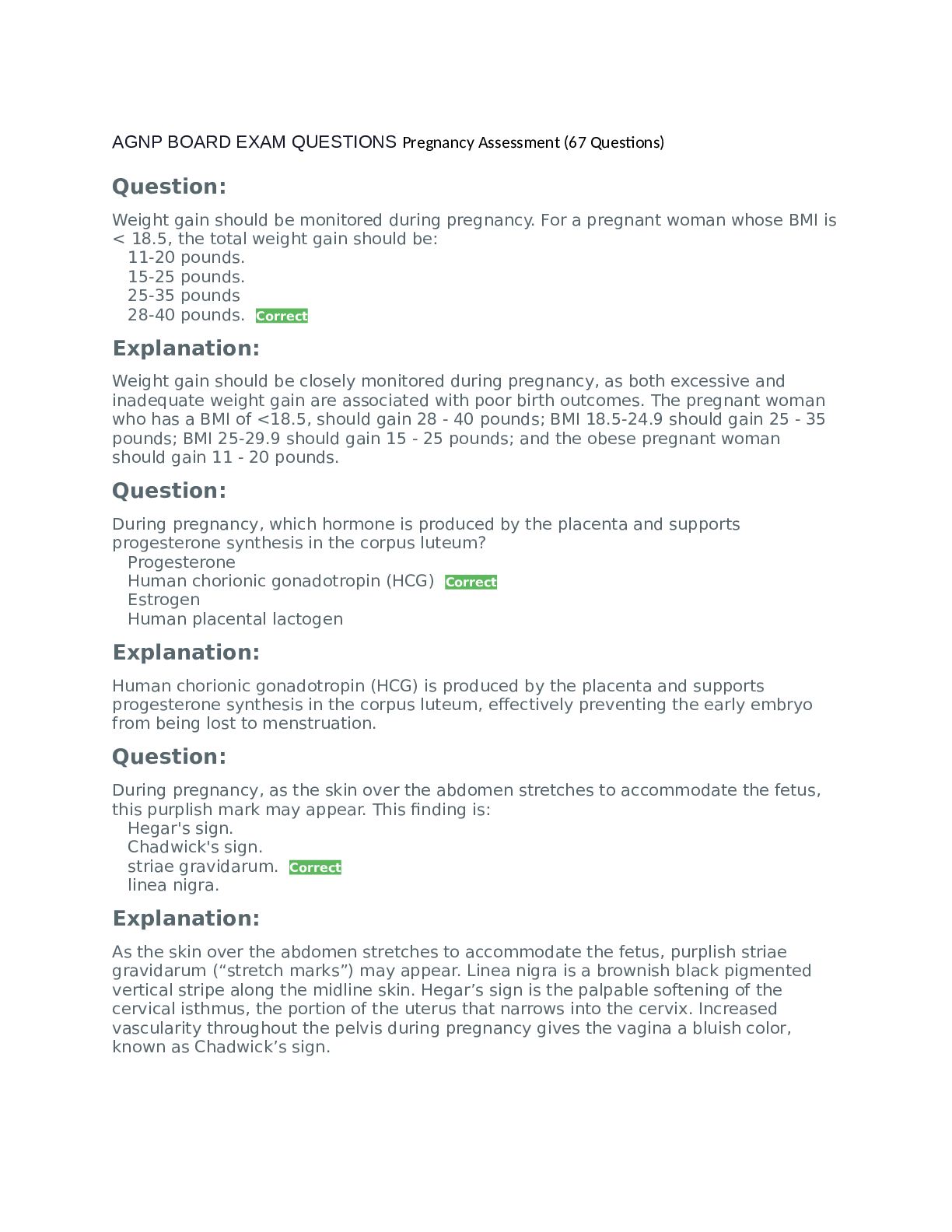
Reviews( 0 )
Document information
Connected school, study & course
About the document
Uploaded On
Apr 22, 2022
Number of pages
20
Written in
Additional information
This document has been written for:
Uploaded
Apr 22, 2022
Downloads
0
Views
54

.png)
.png)
.png)
.png)
.png)
.png)


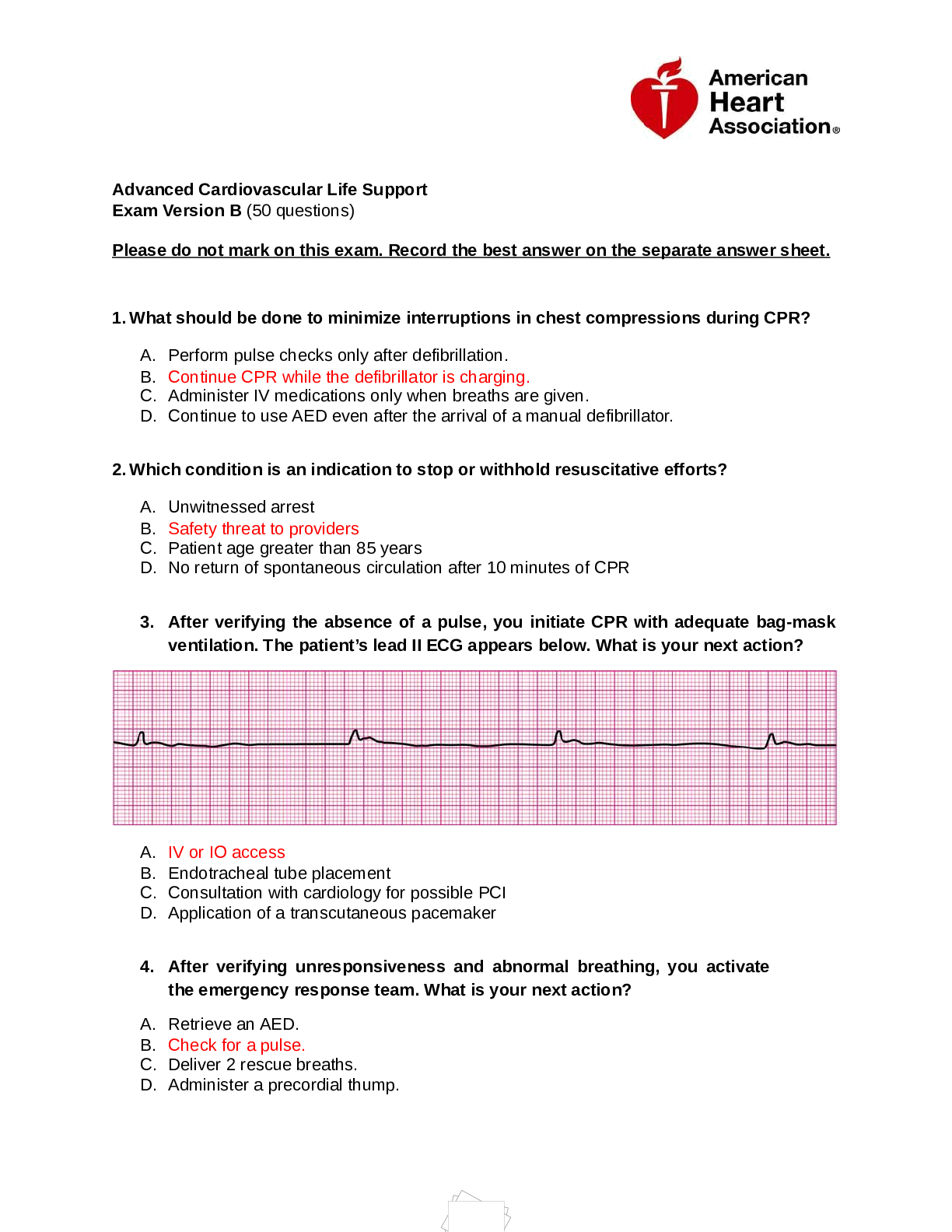


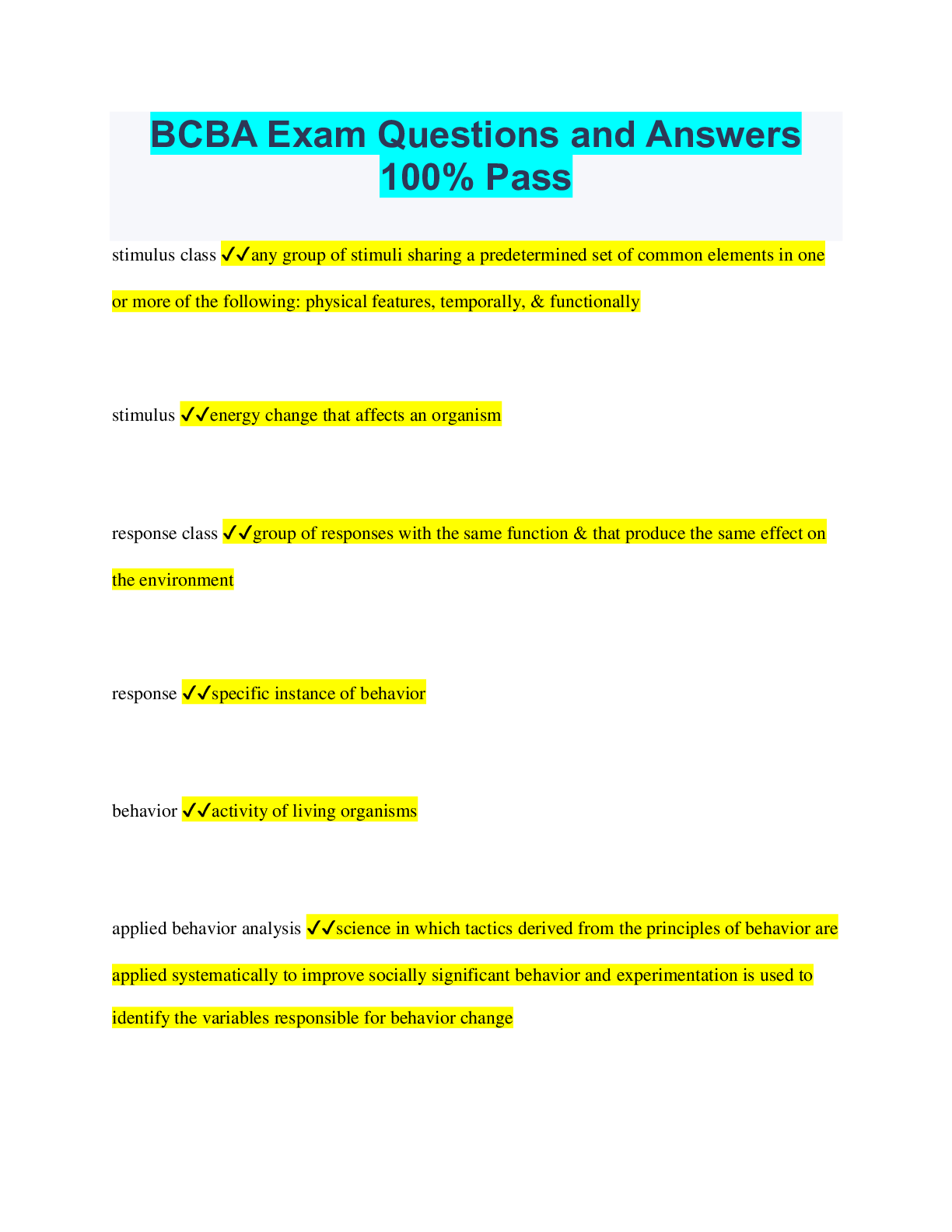
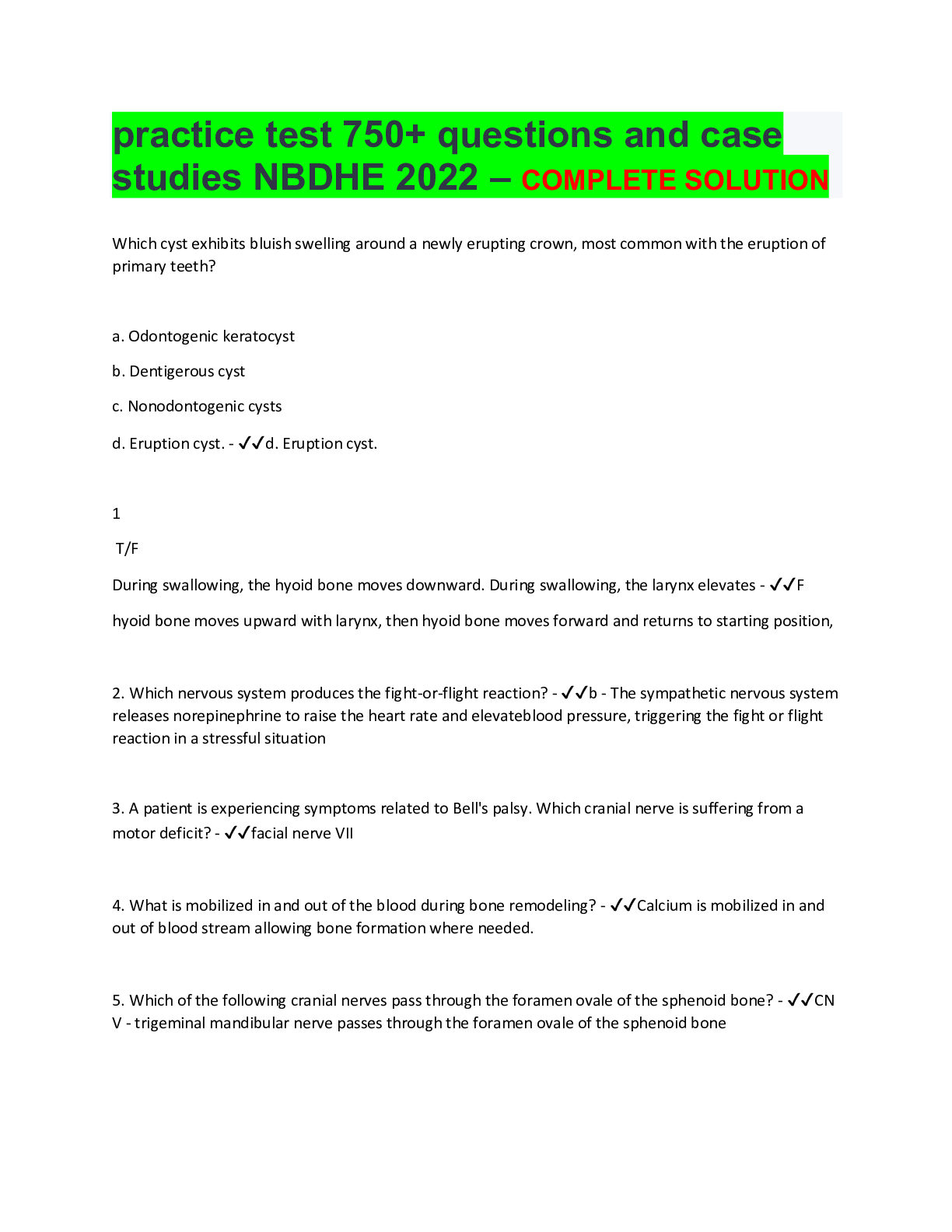

.png)
